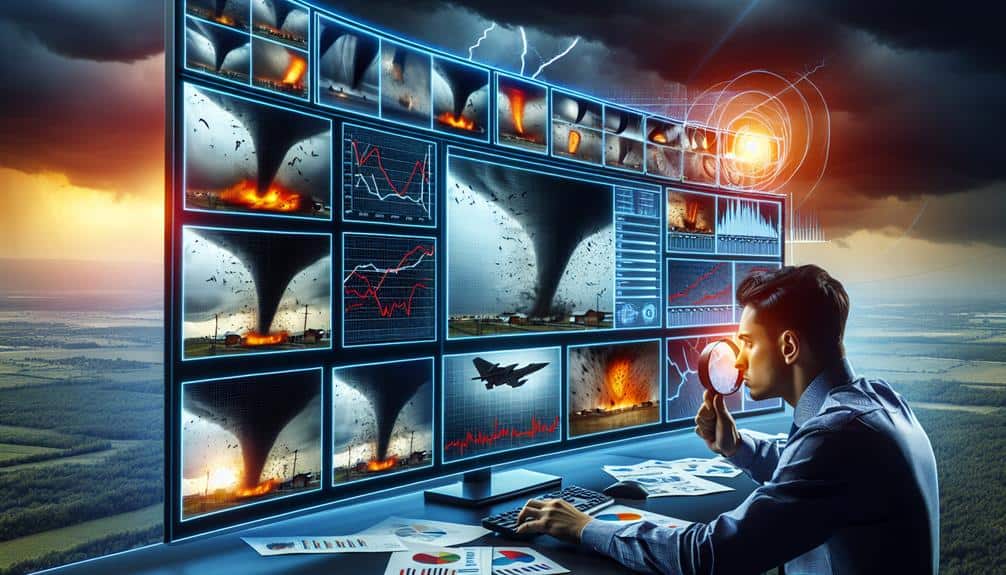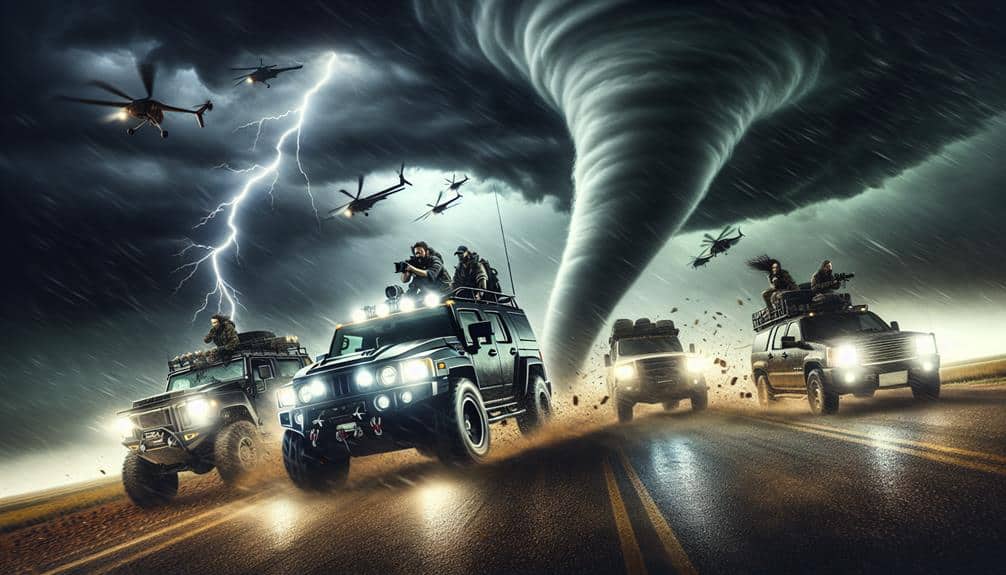Let's analyze storm chaser documentaries with five key tips. First, we'll evaluate realism by scrutinizing the scientific accuracy and ethical adherence to actual field conditions. Next, we'll understand the narratives, focusing on character development and plot structure. Then, we'll assess cinematography, looking at camera techniques and shot composition to capture storm intensity. Fact-checking content ensures the documentary's claims align with verified meteorological data and expert opinions. Finally, we'll gauge viewer impact by analyzing audience feedback and engagement metrics to assess how well the documentary connects emotionally and ethically with its viewers. Discover more by exploring these insights further.
Key Points
- Verify scientific accuracy by cross-referencing meteorological data with documented storm activities.
- Evaluate character development and narrative structure for an engaging and suspenseful storyline.
- Assess cinematography techniques, including camera angles, shot composition, and visual effects, to capture the storm's intensity.
- Fact-check content through expert evaluations and eyewitness testimonies to ensure credibility.
Evaluating Realism
To accurately assess the realism of storm chaser documentaries, we need to examine their adherence to meteorological data and field conditions. By scrutinizing the scientific accuracy of these productions, we can evaluate how well they mirror real-world storm chasing. This includes cross-referencing the presented data with verified meteorological reports and verifying that field conditions depicted align with actual occurrences.
Ethical considerations play a vital role in our evaluation. We must question if the documentaries respect the subjects they depict and avoid sensationalism that compromises scientific integrity. Visual effects, when utilized, shouldn't distort reality but rather enhance our comprehension of the phenomena. It's crucial that these effects remain faithful to the data and don't mislead the audience.
Dramatic reenactments, while captivating, need to be based on fact. They should truthfully represent the conditions and data observed during real events. If these reenactments deviate from reality for the sake of drama, they risk undermining the documentary's credibility.
Ultimately, our goal is to guarantee that storm chaser documentaries offer an accurate, data-driven portrayal of extreme weather events, respecting both scientific accuracy and ethical standards. This approach empowers viewers to make informed decisions about the content they consume.
Understanding Narratives
Examining the narratives in storm chaser documentaries reveals how storytelling techniques can shape audience perceptions of extreme weather events. By focusing on character development and plot structure, we can understand how these documentaries create compelling stories that resonate with viewers.
Character development is pivotal in storm chaser documentaries. We often see protagonists who are passionate, knowledgeable, and fearless, which makes us empathize with their pursuit of understanding and documenting severe weather. By highlighting their personal backgrounds, motivations, and challenges, these films create relatable and engaging characters that draw us into the narrative.
Plot structure plays a significant role in maintaining our interest and conveying the intensity of storm chasing. Documentaries often follow a classic narrative arc: introduction, rising action, climax, falling action, and resolution. This structure helps to build suspense and keep us engaged throughout the film. By presenting real-time footage of storms, interspersed with interviews and expert analysis, the narrative remains dynamic and informative.
Through precise character development and a well-organized plot structure, storm chaser documentaries not only document extreme weather but also captivate and educate us, fostering a deeper appreciation for the risks and rewards involved in chasing storms.
Analyzing Cinematography
When analyzing cinematography in storm chaser documentaries, we focus on how camera techniques, shot composition, and visual effects enhance the portrayal of extreme weather events. Let's start with shot composition. Precise framing and the rule of thirds often guide our eyes to the most critical elements, such as a developing tornado or a lightning strike. Wide-angle shots capture the vastness of the sky, emphasizing the scale of the storm and the smallness of human endeavor against nature's wrath.
Lighting effects play a pivotal role in these documentaries. Natural light, often dramatic and variable, can highlight the intensity of the storm. For example, the interplay of dark storm clouds with sudden bursts of lightning can create a visually arresting contrast. Time-lapse photography, using interval shooting, allows us to observe the storm's evolution, showing its power and unpredictability.
Camera techniques like steady cam and drone shots offer dynamic perspectives. Steady cam can convey the urgency and chaos of the chase, while drone shots provide a bird's-eye view, showcasing the storm's formation and movement over vast landscapes.
Fact-Checking Content
In validating the accuracy of storm chaser documentaries, we examine meteorological data, eyewitness testimonies, and expert evaluations to confirm the content's credibility. Our research process begins by comparing the documentary's assertions with official weather reports from trusted sources such as the National Weather Service and NOAA. This helps us guarantee that the documented events align with recorded meteorological occurrences.
Next, we collect eyewitness testimonies to verify the depicted story. Eyewitnesses provide invaluable firsthand perspectives that either support or challenge the documentary's portrayal of events. We prioritize testimonies from various independent sources to avoid potential biases and ensure a fair credibility assessment.
Expert analyses also play an essential role in our research process. We seek insights from climatologists, meteorologists, and experienced storm chasers to assess the documentary's technical accuracy. These experts can pinpoint inconsistencies or exaggerated statements that a non-expert might miss.
Assessing Viewer Impact

We analyze audience feedback and engagement metrics to understand the impact storm chaser documentaries have on viewers. By examining emotional reactions and viewer engagement, we gather data on how these films resonate. Viewer comments, social media interactions, and survey responses offer a wealth of information.
We focus on three primary metrics:
- Emotional Reactions: Tracking emotional responses, such as excitement, fear, or awe, helps us gauge the documentary's ability to connect with audiences. Advanced sentiment analysis tools can quantify these reactions, providing clear data on viewer impact.
- Viewer Engagement: High levels of engagement, including shares, likes, and comments, indicate that the content is compelling and resonant. We analyze these metrics to determine which elements of the documentaries captivate viewers most effectively.
- Ethical Considerations: We assess how viewers perceive the ethical implications of storm chasing. This includes evaluating whether the audience feels the documentaries respect the subjects' safety and dignity. Balancing thrilling content with ethical storytelling is essential for maintaining viewer trust.
Frequently Asked Questions
How Do Storm Chasers Prepare for Their Expeditions?
We don't just pack sunscreen and snacks. Our expedition planning involves scrutinizing weather models, while safety measures include vehicle reinforcements and emergency gear. Freedom-loving storm chasers embrace precision for survival, not just thrill-seeking.
What Equipment Is Essential for Storm Chasing Documentaries?
For storm chasing documentaries, we need high-quality camera gear to capture intense weather phenomena and reliable editing software for post-production. This guarantees we deliver enthralling, accurate footage while maintaining the freedom to create compelling narratives.
Are There Any Legal Restrictions for Storm Chasing Activities?
Remember how tightrope walkers balance freedom and safety? Storm chasers face similar legal restrictions and must follow safety measures. Regulations vary by region, but permits and adherence to emergency protocols are commonly required to guarantee public safety.
How Do Storm Chasers Ensure Their Safety During Extreme Weather Events?
We prioritize safety by implementing strict safety protocols, using advanced communication strategies, and conducting thorough risk assessments. Our emergency response plans guarantee we can quickly react to changing conditions, minimizing risks during extreme weather events.
What Training Do Storm Chasers Typically Undergo Before Filming?
'An ounce of prevention is worth a pound of cure.' We undergo rigorous training, including safety protocols and extensive field experience. This guarantees we're prepared to handle unpredictable weather while capturing incredible footage, balancing freedom with responsibility.


